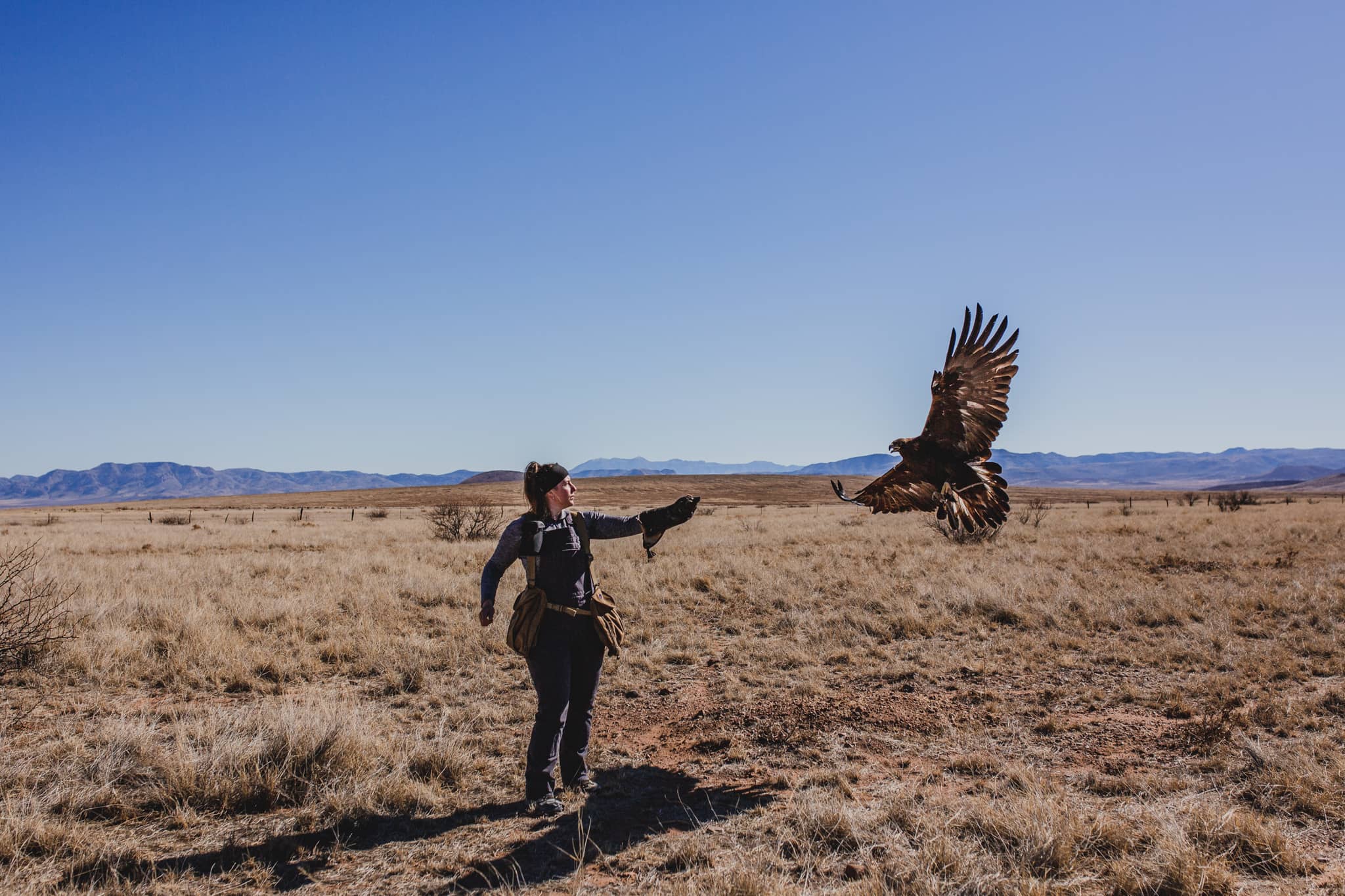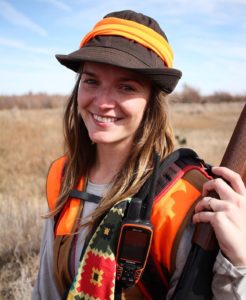
Larger birds of prey, like this eagle, can take down bigger game. DEO Photo by NDPF/AdamPecht.
By Hannah Hayes
Falconry by definition is the hunting of wild animals in their natural state and habitat by means of a trained bird of prey.
The most important word in this definition is “hunting.” There are several avenues a person can take to legally acquire a bird of prey such as education or rehabilitation. But if the person isn’t on the landscape giving the bird the opportunity to catch wild animals in their natural habitat, they are not practicing falconry. This distinction is important because it allows us to focus our efforts on protecting the sport for what it is: hunting.
Falconry is the oldest hunting tradition. Some experts have dated its origins as far back as 8,000 years when it was primarily used for sustenance. Because of its long history, there is a very traditional feel to the sport. The language that we use is very unique to falconry with words like slip – an opportunity for the bird to catch an animal; or mews – the shed-like structure used to house the birds; and bowse – meaning to drink water. The equipment is traditional, with some pieces depicted in falconry art dating back hundreds of years. Its long history and the traditions behind the sport make falconry very special and as a result, drive falconers to do their best to protect it and ensure its longevity.

There are a lot of ways to practice the sport of falconry and the choice in falconry styles will largely depend on the type of bird that’s being flown. The four most common groups of birds flown in falconry include falcons or what are referred to as longwings; hawks, which are also called broadwings or shortwings; smaller raptors, dubbed micros; and, finally, eagles.
Falcon species are what most people are familiar with in the context of falconry and are most commonly used to catch feathered quarry, namely upland game and ducks. Falcons are hunted from a soar and follow the falconer, waiting for them to flush game and give them the opportunity to catch their prey.
Broadwings include species such as red-tailed hawks and Harris’s hawks. These birds are mostly used to catch furred quarry like cottontails, jackrabbits, and squirrels. They are not typically fast enough to catch quarry on the wing (not to say it hasn’t been done) but most falconers are hunting fur with these birds. Broadwings can be flown from a soar, off the fist, or released into trees where they follow the falconer through forested habitat.
Shortwings include species such as goshawks and Cooper’s hawks. These birds can hunt a wide variety of species: cottontail, jackrabbits, squirrels, upland game, and ducks. They are typically flown off the fist.
Micros include species such as kestrels and merlins and will hunt invasive songbird-sized species like house sparrows or starlings. Kestrels are typically flown out of moving vehicles in urban environments and merlins are typically flown on large flocks of birds.
Golden eagles will hunt furred quarry including cottontails and jackrabbits. They too can be flown from a soar or off the fist. There are a few ways falconry birds can be acquired: they can be trapped in the wild, purchased from a breeder, or pulled from nests as chicks.
There are many factors to consider before taking the legal steps to acquire a falconry license.
Do you have the time? Falconry is not a sport for the weekend warrior. These birds must be flown almost every day. The falconry hunting season is typically during the fall and winter when daylight hours are short, so a flexible work schedule is required.
Do you have the resources? Falconry is only fun if you’re successful. It is required to have multiple fields within a reasonable driving distance with plentiful quarry, so the bird has opportunities to succeed every day.
Do you have the support? Falconry is a time-intensive hobby and requires consistency. Will your family, partner, and friends understand why you have to leave for several hours at the same time every day? Will they understand why you can’t go on long vacations or why there’s blood on the counters, dead animals in the freezer, and a squawking bird in the backyard?
Do you have the space? The equipment and required facilities take up a lot of space. Does your yard have enough room for a large shed and fenced in, enclosed area called a weathering yard? If not, is there space in your home where you don’t mind a bird pooping all over place?
Finally, do you have the money? Like any other hobby, falconry costs a pretty penny to get into and requires unique equipment not only for the overall sport, but also for individual birds. If you fly a red-tail one year and want to fly a kestrel the next, you will have to purchase all new, unique equipment.
What falconers lack in numbers practicing the sport, we make up for in our passion for the outdoors and as a result, we play a role in conservation. At the end of the day, falconers are hunters. We are buying our hunting licenses every year. It’s super common for falconers to cross state lines to hunt new quarry or hunt with fellow falconers which means purchasing out of state hunting licenses. We are also required to purchase our falconry-specific licenses such as trapping permits and our general falconry license. These dollars spent on licenses are going directly back into conservation.
Additionally, falconers are a group of sportsmen and women on the landscape that care deeply about our natural resources. We want to see healthy populations of the quarry we chase and the birds we fly. It is not uncommon for falconers to enjoy gun hunting and be part of conservation organization such as Pheasants Forever. I also know several individuals that were introduced to gun hunting through falconry. These folks are purchasing firearms and ammunition too and in other words, funding conservation.
Falconry is a sport not many people give much thought to, but because of its long history, tradition, and role in conservation, it’s a sport worth preserving for generations to come.
 Hanna Hayes is a Dakota Edge Outdoors contributing writer and the Education & Outreach Coordinator for North Dakota Pheasants Forever. She has been practicing falconry for two years and flies a red-tailed hawk.
Hanna Hayes is a Dakota Edge Outdoors contributing writer and the Education & Outreach Coordinator for North Dakota Pheasants Forever. She has been practicing falconry for two years and flies a red-tailed hawk.
